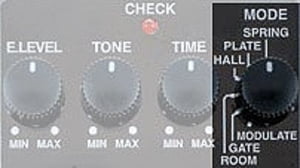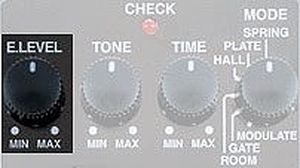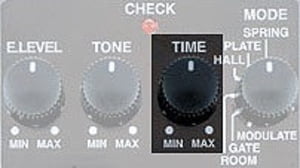5. Parameters
Whether in hardware or software form, digital reverb solutions tend to share a basic set of controls, although not all of these come into play in the case of classic hardware emulation:
Mode/Reverb Type
This control allows selection between various basic programs which may include a variety of natural reverb simulations and classic reverb devices. These may include:

- Room: designed to emulate the sound of a small-to-medium sized space. Room reverb is usually uncoloured, and works by adding an important sense of depth, without the listener necessarily being consciously aware of the presence of reverb.
- Hall: here the sense of a large space comes into play, and the listener is definitely aware that there is reverb in the mix. Hall reverb should generally be used for effecting individual instruments rather than a whole mix, taking special care not to swamp the whole production in reverb (see mix control below.)
- Church: this is essentially like a very long hall reverb, though churches are usually characterised by a rather trebly or cold sound, as almost all the reflecting surfaces are made of stone. Like hall reverb, this effect can easily be over-used, but has a musical place, and can also turn almost any percussion sound into a sound effect. Turn the mix control to 100%, and a single bass drum can be made to sound like the gates of hell slamming shut. Which is nice.
- Spring/plate: these programs are designed to emulate vintage spring/plate reverb units rather than natural reverberation.
- Gated reverb: this technique became particularly popular in 80s pop production (think of Phil Collins In The Air Tonight drum sound). In the studio, reverb should usually be re-combined with the dry signal within the mixer (or nowadays the mix page/screen) rather than the reverb unit. This allows maximum flexibility - the returning signal can be compressed, gated, EQd or subjected to any other effect available. Gating allows the use of large reverbs for sonic effect without completely swamping the mix, and works very well with percussive sounds such as snare drum - the reverb effect adds depth (and length) to the basic sound, but the gate cuts the reverb once it has decayed below a given level, leaving space for other elements in the mix. For convenience and live use, gated reverb is often included as a pre-defined effect in budget units, multi-FX and pedals.
Mix/Effect Level
This controls the balance between the dry (unaffected) signal and the reverb itself. Adjusting this parameter is broadly equivalent to moving the listening (or microphone) position from very close to the source to the back of the hall - mix settings approaching 100% wet in fact represent a balance that would rarely occur naturally.
Reverb Time/Decay
This allows manual control of reverb time, or the rate at which reverberating sound decays, and usually operates within the context of the basic program selected. In other words, setting this control to max will give a much longer reverb time when used with a cathedral reverb program than with a room reverb.
Pre-Delay
This parameter is not always available, as it is often incorporated into the basic reverb program settings. Pre-delay governs the length of time before any reverb signal at all is heard. This is important for realism in almost all listening positions in real venues, the direct or dry sound reaches the listener before any reflected sound.





